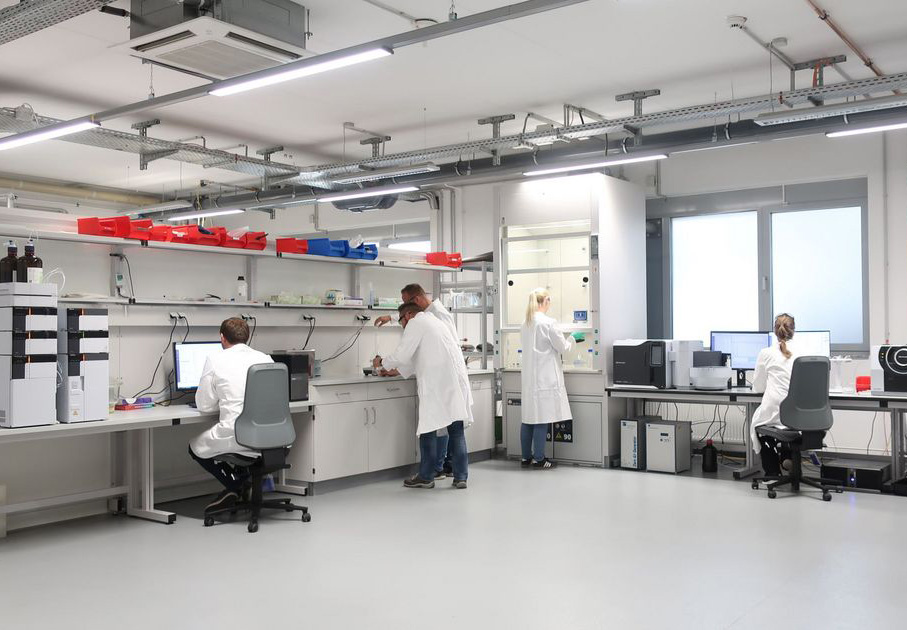

From aging resistance to tensile testing - Our expertise for materials in vehicle interiors
Materials testing involves intensive examination of materials in vehicle interiors. Emissions from these materials can have a direct impact on the senses and well-being of drivers and passengers. We evaluate plastic emissions as well as surfaces according to current regulations and assess their suitability for the respective application. This also includes combined material and component tests.
Thanks to our close networking with related disciplines such as testing, design and development, we offer comprehensive solutions from a single source. This enables us to respond to your individual material or test part requirements, even beyond DIN standards and customer testing norms.
Our laboratory expertise, component competence and customer familiarity enable us to develop new standards and testing requirements together with customers. Here we act as a testing partner, co-developing material concepts and testing standards to meet the requirements of the future, whether for new vehicle usage forms such as car sharing or other innovations.
From odor testing to tensile testing, our testing laboratory covers a wide range of tests. Legal limits, odor expectations and OEM requirements are our guidelines for conducting and testing the outgassing behavior of plastics. We investigate emissions in specialized test facilities and analyze pollutants. We also subject materials to a variety of tests, including scratch tests, tensile tests, media resistance and UV aging.
Browse through our services and order your tests directly online!
Testing the abrasion resistance and/or rub fastness of flocked (velvet) plastic parts and dyed or printed textiles or films.
Simulation of the load on the floor covering in the area of the accelerator, brake and clutch pedal by a (shoe) heel made of rubber to determine the wear resistance. The test ensures that the materials for the interior lining meet the required quality and durability standards.
Test to determine the adhesive force and sliding force between the floor mat and the floor covering. Note: Direction of travel must be marked on the samples
Testing for small components: 0.6-10 m³ The influence of environmental factors such as Temperature can cause age-related changes in polymer materials. These can be optical and dimensional changes or changes in the mechanical properties. The test in the climate chamber simulates certain ageing cycles in order to obtain meaningful results about the ageing values.
Low-Temperature Behaviour of Plastic Components Determination of the toughness of plastics for exterior components at risk of impact at low Temperatures for components such as panels, foils, trim, etc. made of organic materials
Test for evaluating the impact resistance of plastics used for components in outdoor areas, in particular by means of the ball drop test. Test to determine the material behaviour during ball drop in tempered circulating air
Exposure of the samples to filtered xenon arc light to determine the adhesive strength (tack) between the polypropylene parts and other materials or coatings used.
Testing the brush abrasion of textiles with Schopper circular scourer to simulate typical use. Method for evaluating the resistance of textile materials exposed to brush action. Determination of the abrasion resistance of the textile, by measuring factors such as pilling, fluffing or surface deterioration.
Test for determining the flammability behaviour of materials used in the interior trim of motor vehicles. The standard outlines the test methods and requirements for assessing the flammability and fire resistance of these materials. The material samples are exposed to controlled ignition sources and their burning behaviour, such as flame propagation, duration and smoke development, is observed. No country approvals
Resistance of unpainted thermoplastic surfaces in the interior and exterior to media (liquids). The test is used to evaluate the chemical resistance of materials. The optical and haptic change is tested.
Test of susceptibility to cracking, deformation or loosening of the bond on individual parts (variant A) under climatic cycle conditions. The test involves exposing the parts to changing climatic conditions, usually involving changes in Temperature and humidity. The test is used to evaluate the performance and durability of the parts, particularly with regard to their resistance to cracking, deformation or failure of joints.
Simulation of environmental influences on components to identify optimisation potential: For example, exposing vehicle parts to extreme Temperatures to evaluate performance, durability and material integrity.


